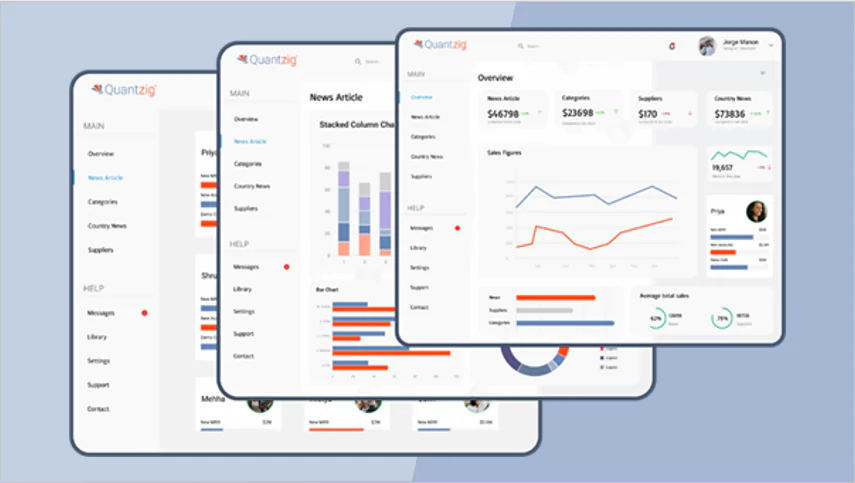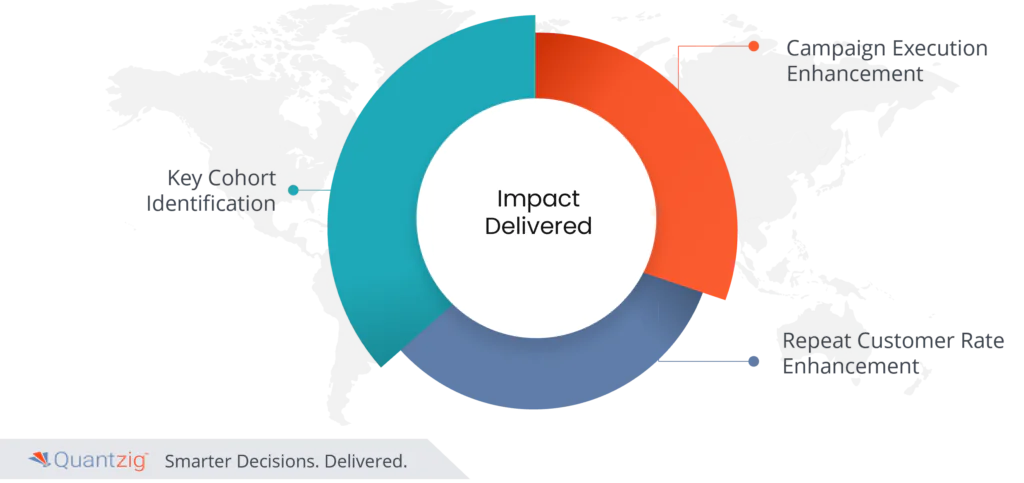Measuring campaign effectiveness is crucial for businesses to understand the outcomes of their marketing efforts and devise strategic responses accordingly. Mastery of assessing and interpreting key performance indicators (KPIs) is essential for marketing professionals seeking data-driven insights into the success of their campaigns. This case study sheds light on how Quantzig’s innovative campaign analytics solution helped a leading multinational Athleisure brand to identify key cohorts of customers and their propensity levels and experience an increased repeat customer rate by 20% for the test period an impactful example of maximizing ROI through data-backed strategies.
Book a demo to experience the meaningful insights we derive from data through our analytical tools and platform capabilities. Schedule a demo today!
Request a Free DemoTable of Contents
Quantzig’s Success story
| Client Details | A leading multinational Athleisure brand headquartered in Europe. |
| Challenges Faced by The Client | The client’s Ecommerce team encountered the challenge of effectively identifying and targeting transactional customers likely to become repeat purchasers. |
| Solutions Offered by Quantzig | Quantzig’s solution involved constructing a comprehensive Customer 360 Datamart, identifying key attributes influencing purchase behavior, determining customers with higher propensities, and devising activation plans for both website and campaign customer journeys. |
| Impact Delivered | Identify key cohorts of customers, and their propensity levels, optimize marketing campaign strategies, and experience an increased repeat customer rate by 20% for the test period. |
Client details
Our client, a leading multinational Athleisure brand headquartered in Europe, boasts an impressive annual revenue exceeding $8 billion. With a keen focus on bolstering their online presence, the client’s Ecommerce team sought a solution to identify transactional customers with high propensities for repeat purchases.
Challenges faced by the client
The client’s Ecommerce team encountered the challenge of effectively identifying and targeting transactional customers likely to become repeat purchasers. In an increasingly competitive market, understanding customer behavior and driving repeat purchases was paramount to sustaining growth and profitability.
Solutions offered by Quantzig
Quantzig embarked on a comprehensive solution journey to address the client’s challenges:
- Customer 360 Datamart Development: Leveraging demographic, transactional, channel, and behavioral data, Quantzig constructed a robust Customer 360 Datamart to provide a holistic view of customer interactions and preferences.
- Attribute Identification: We identified potential attributes influencing purchase behavior, laying the foundation for precise customer segmentation and targeting.
- Propensity Modeling: Through advanced analytics techniques, our analytics experts identified customers with higher propensities for repeat purchases and pinpointed the key attributes driving propensity levels.
- Activation Plan Development: Quantzig proposed activation plans tailored to both inner loop (Website) and outer loop (Campaigns) customer journeys, ensuring targeted and personalized engagement strategies.
Impact Delivered
Quantzig’s interventions led to transformative results, significantly enhancing the client’s customer retention efforts. By meticulously analyzing customer data, Quantzig identified key customer cohorts and their propensity levels, allowing for more targeted and systematic retargeting initiatives. Leveraging actionable insights, the team empowered the client to optimize campaign execution strategies, refining customer pool identification, messaging tactics, and performance measurement with ROI best practices. As a result of these strategic interventions, the client experienced a remarkable 20% increase in repeat customer rate during the test period, further validating the effectiveness of the implemented solutions and maximizing overall ROI.
Quantzig’s collaboration with the multinational Athleisure brand exemplifies the transformative power of data-driven insights and analytics in enhancing customer retention and driving sustainable business growth. By leveraging advanced analytics capabilities and strategic expertise, we continue to empower businesses worldwide to navigate complex challenges and unlock new avenues of value creation.
What is Campaign Effectiveness Measurement: A Deep Dive
Campaign measurement is the systematic evaluation of marketing or advertising initiatives to gauge their efficacy in achieving predetermined objectives. This process entails an in-depth examination of key performance indicators (KPIs) to reach campaign objectives. While typically conducted post-campaign, real-time measurement allows for agile adjustments to optimize impact.
A comprehensive campaign measurement framework is indispensable for informed decision-making and resource allocation. It elucidates the campaign’s efficacy in reaching target demographics, fostering lead generation, and catalyzing conversions. Failure to undertake robust measurement enhances resource allocation efficiency and inhibits potential growth opportunities.
Through diligent campaign measurement, organizations glean invaluable insights into effective strategies and areas necessitating refinement. Such data-driven insights empower stakeholders to fine-tune marketing endeavors, ultimately maximizing ROI and aligning strategies with a practical ROI optimization framework.
Experience the advantages firsthand by testing a customized complimentary pilot designed to address your specific requirements. Pilot studies are non-committal in nature.
Request a Free PilotThe Hidden Metrics of Winning Campaigns
As the market evolves, and companies are increasingly shifting towards digital and direct-to-consumer channels, the importance of measuring campaign effectiveness cannot be overstated. As customers seek to be heard and understood by the brands they engage with, understanding and optimizing marketing efforts through key performance indicators (KPIs) such as return on investment (ROI), return on ad spend (ROAS), and customer lifetime value (CLV) becomes imperative.
With digital marketing campaigns playing a central role in reaching and engaging consumers, timely improvements based on real-time measurement of campaign effectiveness are essential. Utilizing marketing tools like the Google Campaign URL Builder, Cost Per Lead (CPL), Cost Per Acquisition (CPA), and digital marketing attribution models powered by artificial intelligence (AI) enables precise measurement and optimization of marketing campaigns.
By adhering to a structured measurement schedule and utilizing insights to enhance marketing campaign management, brands can navigate the digital landscape effectively, ensuring maximum impact and maximizing ROI across all efforts.
Utilizing a standardized Marketing Campaign Report Template streamlines the analysis process, allowing for comprehensive assessment of metrics such as average session duration and search engine results pages (SERPs) rankings. Embracing strategies like performance marketing ensures focused efforts towards achieving desired outcomes, driving success in the competitive digital landscape.
What Does It Mean to Measure a Marketing Campaign’s Success?
Measuring the success of a marketing campaign involves evaluating its performance against predefined objectives and key performance indicators (KPIs), including audience reach, engagement, lead generation, and conversion rates. Success is marked not only by achieving these metrics but also by contributing to broader business goals such as revenue growth, brand awareness, and customer loyalty.
To do this effectively, marketers must analyze campaign data using tools like Google Campaign URL Builder and metrics such as ROI, ROAS, CPL, CPA, and CLV. Real-time performance tracking—supported by AI-powered attribution models—enables timely adjustments that optimize outcomes. Metrics like average session duration and SERP rankings further enhance insight into campaign impact. Implementing a structured measurement schedule and using a standardized campaign report template ensures consistency and clarity in evaluation. Ultimately, leveraging performance marketing strategies and data-driven insights helps marketers refine future campaigns and maximize return on investment.
Metrics to Measure Campaign Effectiveness
In the marketing, the ability to gauge the effectiveness of campaigns is paramount for businesses striving to maximize their return on investment (ROI). This necessitates a comprehensive understanding of key metrics and performance indicators, which serve as the bedrock for informed decision-making and strategic optimization. In this discourse, we delve into essential metrics for measuring campaign effectiveness, illuminating their significance and implications for marketing endeavors across diverse industries and objectives.
- Return on Investment (ROI): ROI is the quintessential metric in marketing evaluation, encapsulating the financial success of a campaign by juxtaposing earned revenue with the investment expended. It serves as a barometer of profitability, guiding strategic decisions and resource allocation. A robust ROI indicates effective campaign execution and optimal resource utilization, underlining its significance as a cornerstone metric in assessing marketing efficacy.
- Return on Ad Spend (ROAS): ROAS delineates the effectiveness of advertising endeavors by contrasting revenue generated from ads with the corresponding expenditure. It offers insights into the efficiency of ad campaigns, with lower ROAS signaling a need for strategic adjustments to enhance profitability and maximize returns on advertising investments.
- Conversion Rate: Conversion rate embodies the percentage of audience members who take desired competitive actions, be it making purchases, signing up for leads, or requesting demos. It serves as a tangible measure of campaign effectiveness, reflecting the resonance of marketing initiatives and their ability to drive desired outcomes.
- Cost per Lead (CPL): CPL quantifies the expenditure incurred per acquired lead, particularly pertinent in B2B landscapes and industries characterized by prolonged sales cycles. This metric illuminates the efficiency of lead generation efforts, guiding investment decisions and resource allocation strategies.
- Cost per Acquisition (CPA): CPA delineates the cost incurred per new customer acquired, providing invaluable insights into the efficiency of customer acquisition initiatives. It serves as a key performance indicator for campaigns aimed at expanding brand reach and fostering customer growth.
- Website Visits: Website visits epitomize the influx of traffic attributable to a marketing campaign, serving as a fundamental metric for assessing its online impact and effectiveness in driving audience engagement.
- Website Visits by Traffic Source: Segregating website visits by traffic source offers granular insights into the efficacy of distinct marketing channels in driving traffic. This breakdown informs strategic decisions regarding channel optimization and resource allocation.
- Click-Through Rate (CTR): CTR quantifies the proportion of audience members engaging with marketing content by clicking through, offering insights into messaging effectiveness and audience resonance.
- Cost per Click (CPC): CPC quantifies the cost incurred per click on advertisements, providing actionable insights into audience targeting effectiveness and the efficiency of calls-to-action.
- Impressions: Impressions signify the frequency of audience exposure to ads or content, serving as a vital metric for evaluating campaign reach and the effectiveness of channel selection and targeting strategies.
In conclusion, effective campaign measurement serves as the cornerstone of marketing strategy, offering invaluable insights into the efficacy of initiatives and guiding future investments. By leveraging key metrics such as ROI, conversion rates, and CPC, businesses can refine their approaches, optimize resource allocation, and ultimately enhance their bottom line. Embracing a data-driven approach to campaign evaluation empowers organizations to adapt to dynamic market conditions, resonate with target audiences, and drive sustainable growth in today’s competitive landscape.
Conclusion
In conclusion, optimizing campaign effectiveness entails a holistic approach that integrates best business practices across various dimensions of marketing strategy and execution. By prioritizing data-driven decision-making, leveraging advanced analytics tools, and embracing agile methodologies, businesses can unlock new levels of performance and achieve sustainable growth in today’s competitive landscape. Moreover, fostering a culture of experimentation and continuous improvement allows organizations to adapt to evolving market dynamics and customer preferences, ensuring relevance and resonance in their campaigns. Ultimately, by embracing these best practices and cultivating a relentless commitment to innovation and optimization, businesses can drive meaningful results, enhance customer engagement, and solidify their position as industry leaders in the digital era.




